If you’re planning on doing the Salar de Uyuni tour from San Pedro de Atacama in Chile and looking for detailed information about the adventure then you’ve come to the right place! This page will discuss everything there is to know about exploring the magical Bolivian salt flats when you’re coming from the Atacama Desert in Chile.
The Bolivian salt flats, Salar de Uyuni, are the largest and highest salt flats on the planet. Covering 3900 square miles at an elevation of nearly 12,000 feet (3650m), you won’t find anything else quite like this elsewhere in the world.
If you are not familiar with salt flats, it’s exactly what it sounds like; a flat plain of salty earth. The landscape is truly fascinating. We loved every minute of our tour and still dream of that sunrise over the salt flats. The tour featured so much more than just the salt flats though, so read on to see what this part of the world has to offer and why you should book that trip to Bolivia starting in San Pedro de Atacama, Chile!
Note: this article contains affiliate links, which means that should you purchase something or get a quote through them I may make a small commission at no additional cost to you. This helps keep the site running with up to date information. I do not represent World Nomads, Booking.com, or GetYourGuide. This is information only and not a recommendation to buy the product mentioned in this article.
Salar de Uyuni – What You Need to Know
Where is Salar de Uyuni?
Salar de Uyuni is in the southwestern corner of Bolivia, high in the Andes Mountains. The closest major city is La Paz, Bolivia, though many places in Chile are far closer.
How to get to Salar de Uyuni
There are multiple options for how to see the salt flats, ranging from doing it yourself using public transportation to a multi-day organized tour. The quickest way will be to fly to the town of Uyuni from La Paz or Santa Cruz and take a day tour from there.
However, for a more fascinating tour of the volcanic landscape of the Andes in southwest Bolivia I highly recommend doing a 4-day / 3-night Salar de Uyuni tour from San Pedro de Atacama, Chile. This post focuses on that option.

Salar de Uyuni from San Pedro Tour Cost
It’s possible to see the salt flats on your own, but you will see so much more with an organized tour. The tours are very cheap, as Bolivia is a very poor country. We went with Lithium Aventura (Lithium Adventures). Including transportation, lodging, all food, and the guide, it cost only about $50 USD per person per day, which is pretty standard for the basic tours.
There are more luxurious tour options, and if you opt to do a private tour and not a combined group tour you’ll naturally pay well more than this.
Money
The currency in Bolivia is Bolivianos and if you want to purchase anything from the local towns you will need cash. You likely won’t encounter a bank or ATM until you get to the town of Uyuni after you visit the salt flats, so you will need to get some Bolivianos in San Pedro de Atacama. You will also need cash for tipping your guide/driver, though they will be happy to accept USD or EUR.
Weather and when to do the tour
The weather is tricky up in the salt flats. You are very high in elevation, so nights and mornings can be very cold. But when the sun shines during the day it reflects off the white salt and it can be very hot.
It doesn’t rain much at Salar de Uyuni – only 5 inches per year – and if it does rain your trip could be ruined as the salt flats will flood. It can be beautiful to see this layer of water on the flats, reflecting the nearby mountains, but it can seriously hamper your movement around the flats.
The rain usually falls in summer (Dec – Feb) so to be safe your best time would be outside of those months, though it will be a bit colder. That being said, I went in January and it only rained and that was on the first day. Luckily it didn’t rain up in the salt flats for me. The best time of year to visit would be Feb-April and Oct-Nov.
Language
Your tour guide/driver and the people working at local hotels and cafes will most likely not speak any English. If no one in your group speaks Spanish, you will miss out on some of the information the guide can provide. Our guide could only speak a few words of English, though we had one person on our tour that spoke Spanish, so that really helped.
Food on the tour
This part of Bolivia is not really for foodies. Don’t expect great food here in the mountains. The meals provided on the tour are mediocre at best. They are mostly rice and meat based or pasta based. Talk to the tour operator when you book if you’re a vegetarian and see what they can arrange for you.
I will say, however, that the mangoes I bought on the side of the road in Uyuni were the best mangoes I’ve ever tasted in my life. If you see fresh fruit for sale, it’s gonna be pretty damn good.
Salar de Uyuni elevation
If you have ever struggled with altitude sickness you should speak with your doctor before committing to this trip. Most of the trip is spent high in the mountains, considerably higher than you can go in the United States unless you’re climbing Denali in Alaska.
You will top out at about 16,250 feet (4950m) and not get any lower than about 12,000 feet (3650m). There is not really any time to acclimatize, but San Pedro itself is about 7900 feet (2400m) so if you spend a few days there first it will help. There is not much hiking on the tour, so that helps with avoiding altitude sickness.
Wildlife
You should expect to see quite a few llamas and thousands of flamingos, but not much else, maybe an elusive fox or two. There is very little vegetation along the tour route, so not ideal grounds for wildlife. You also won’t see a tree the entire trip, just a few species of cactus.
Poverty and litter
Bolivia is a pretty poor country. Nearly 40 percent of the country lives in poverty, and it’s higher in rural regions where you will be on this tour. The extreme poverty makes it very cheap to travel here, but remember how fortunate you are compared to the locals when you are there.
In a small village in the mountains I played soccer with a little boy named Santiago on a dirt pitch without a single patch of grass with a dilapidated old ball. It broke my heart seeing this kid playing in such poor conditions and knowing that he’ll likely never be able to experience playing on a grass pitch. Of all the poverty I saw in Bolivia, this image sticks with me.
I am always saddened to see the amount of litter everywhere in developing nations, and Bolivia was no exception. Sanitary services are lacking and locals just throw their garbage anywhere. As a tourist, do your part to keep Bolivia beautiful and don’t litter just because the locals do it.
Tourist Visa
Bolivia offers visa free travel for nearly everyone from developed nations. But not for Americans. If you’re an American going to Bolivia you need to be prepared with $160 USD of cash (in good condition) to pay when you enter the country, whether by air or land. There are some forms and you need to show proof of travel accommodations and proof you will leave the country.
Technically you are also required to show you have been vaccinated for Yellow Fever, but if you do the Salar de Uyuni tour from San Pedro de Atacama this will not be required, as the elevation you will be at is so high that mosquitoes are not present. If you are going to Uyuni a different way, like through the airport in La Paz, be prepared to show your vaccination card.
Where to stay in San Pedro de Atacama
To do this tour you’ll base yourself in the Chilean resort town of San Pedro de Atacama. It’s a beautiful little town that is catered to tourists so you have a ton of options for booking your hotel or hostel.
We stayed at Hostal Candelaria and highly recommend it for a comfortable and very affordable stay. We had a few nights booked at a $200/night resort outside of town and had such a horrible experience we left after one night and went back to Candelaria.
You can check out all the properties in San Pedro de Atacama on booking.com here.
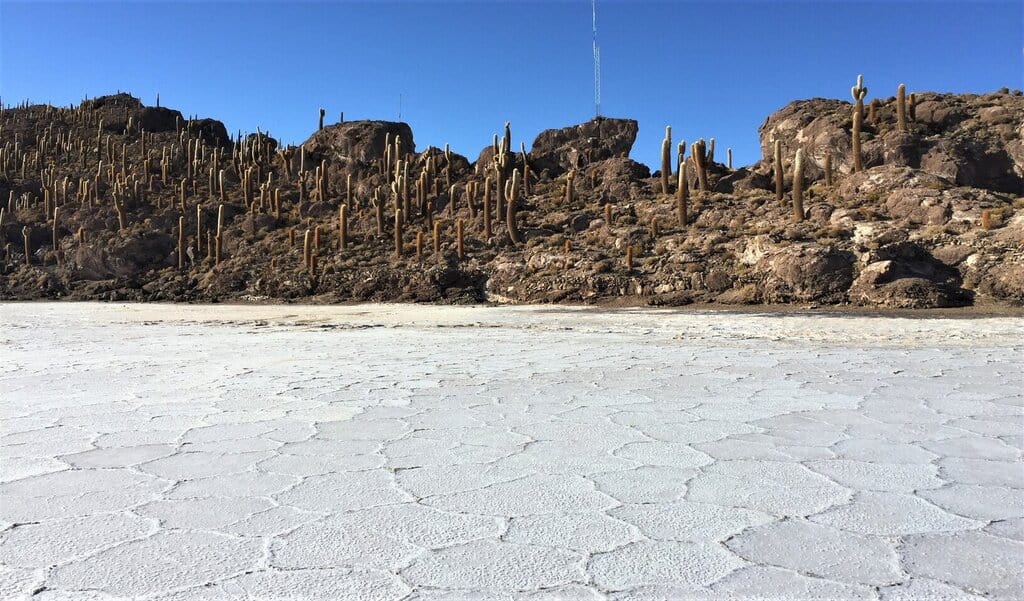
Travel Insurance
For your trip across the desert I recommend purchasing travel insurance so that you’re protected for the unexpected. We use World Nomads and had a good experience the one time we unfortunately had to actually use it. World Nomads provides coverage to travelers in over 100 countries. You can search for a coverage plan using the link below.
Booking Your Salar de Uyuni Tour
As mentioned before, the best way to see Salar de Uyuni is with an organized tour and this post focuses on the 4 day / 3 night tour from San Pedro de Atacama, Chile.
If you are on a very, very tight budget you can see the salt flats on your own, but you will miss out on a lot of amazing places that you can only get to with a 4×4 off-road vehicle. For the vast majority of the drive there are no actual roads. You cruise along sandy trails and drive freely on the salt flats.
The tours are all small groups, as only 6 or 7 people can fit into the SUVs that the tour companies use, so it doesn’t even feel like a group tour. Using a licensed tour company is absolutely the way to go.
How to book the tour
It is easy to book a tour online by email with one of the operators or using an online tour booking platform like GetYourGuide. You can check out the various options for a Salar de Uyuni tour from San Pedro de Atacama using the banner below.
But even if you don’t plan ahead, you will have no problem booking something in San Pedro. There is always availability to squeeze a few more people in. We literally booked our tour the day before it left.
In the city center there is a street that is lined with tour offices. Posters on the window advertise various tours. Nearly all the operators will offer tours to Salar de Uyuni and they will all offer a pretty similar experience.
We chose Lithium Adventura based on online reviews and the fact that someone at their office spoke English. I can certainly recommend them, but can’t say the others aren’t just as good. They were up front about how our guide/driver would not speak English so we appreciated that.
I also appreciated that they warned me that as an American I would need $160 of cash in USD (see visa requirements above). I had to go to a bank and withdraw cash in USD. You can also go to an exchange kiosk, as these are everywhere around town.
More interested in hiking in the Andes? Then the Inca Trail to Machu Picchu might be for you!
We paid for the tour in cash directly to the office and we were booked for a 7:20 AM pickup the next day. The process was incredibly easy. My biggest gripe was that my Bolivian visa would cost more than the tour itself!
When we did the tour it was about $150 USD for a 4 day / 3 night tour (currently more like $200-$300 as of 2023). It’s an incredibly affordable trip for what you get.
PRO TIP: if you’re on a longer jaunt around South America don’t take all your luggage with you on the tour. Make sure to book ahead where you will stay on the day you get back to San Pedro and go there beforehand to drop your bags. In the SUV there is not much room and all luggage is kept atop the vehicle. Pack lightly if you can.
Salar de Uyuni Tour Basics
There are various tour options for Salar de Uyuni from San Pedro de Atacama. The most popular – and the one we did and have dedicated this post to – is the 4 day / 3 night San Pedro to Uyuni and back excursion. The tour includes three nights of lodging in basic accommodations as well as food, which is typically served at the lodges (though really they are more like hostels).
Accommodation types
The type of room you get at the lodges seems to vary based on what’s available at the lodge that particular day. The first night we slept in a dorm style room with four of our tour mates in the middle of nowhere. The other two nights we had private rooms with twin beds.
The rooms were very basic. There was no AC or heat, but the weather was pretty temperate so that didn’t really matter. Electricity is off and on. You are off the grid here so everything is run on generator power. Bathrooms will be shared.
Meals will be served at specific times (dinner is late in the evening) and will be pretty basic rice or pasta based entrees. An appropriate way to describe the food would be mediocre at best.
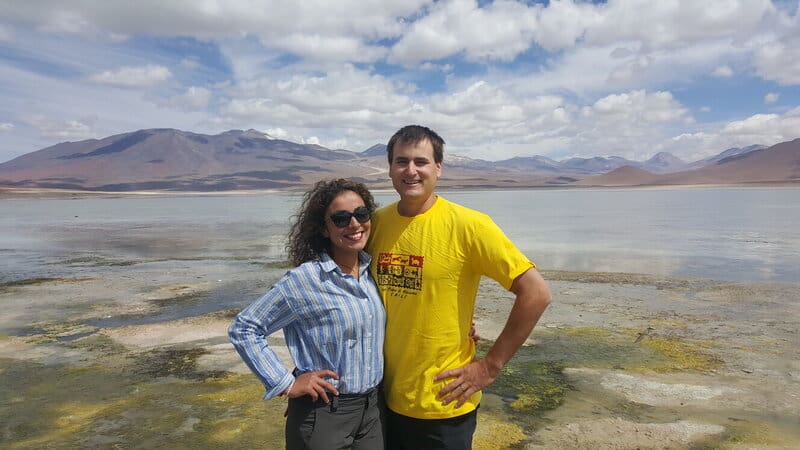
Days in the Jeep
You will spend most of your day packed in the SUV riding across dirt and sand so try to get comfortable. The SUVs are reliable, but old. The tour is off road, so breakdowns are relatively common. The drivers are all basically licensed mechanics though, so you’re not gonna get stuck.
If all this sounds a bit much like roughing it to you there are other more luxurious options. Some tour operators will offer upgrades to stay overnight at actual hotels, but you also have the option to book a private tour tailored to your needs. There are some pretty glamorous hotels near the salt flats. Expect these private tours to be anywhere from 5 to 25 times the cost of a group tour however.
Salar de Uyuni Tour Highlights
The route between San Pedro and Salar de Uyuni is loaded with spectacular sights. Conical mountains of active volcanoes rise from the red and brown valley. You won’t see a tree anywhere around here. Pink flamingos fly around you as smoke from geothermal pools of boiling water carries off into the distance. Valleys of endless sand and funky rocks stretch on as far as the eye can see. And you still haven’t even reached the salt flats.
After experiencing this exotic landscape of what seems like it should be another planet you reach the flats. Here you freely drive along the endless white plains of salty earth, small mountains covered in giant cacti scattered here and there. (Note that the route shown in the map below is not an exact representation of the trip, as Google Maps cannot account for all the off-roading that is done)

Day 1
After being picked up from your accommodation in San Pedro de Atacama you will ride on a bus to the Bolivian border. You’ll climb straight up about 5000 feet in elevation until you’re as high as the tip of the tallest mountain in the contiguous United States.
At the border you’ll get split into the smaller group that you’ll be with for the rest of the tour. We ended up in a Land Cruiser with 4 other travelers and our driver, Carlos.
You will spend the entire first day in Eduardo Avaroa National Reserve of Flora and Fauna. This is a large national park that costs an extra 150 Bolivianos (about $22 USD, not included in the tour). Known for its lakes full of flamingos and giant volcanoes, you’ll most likely spend your first night here in a very basic lodge.
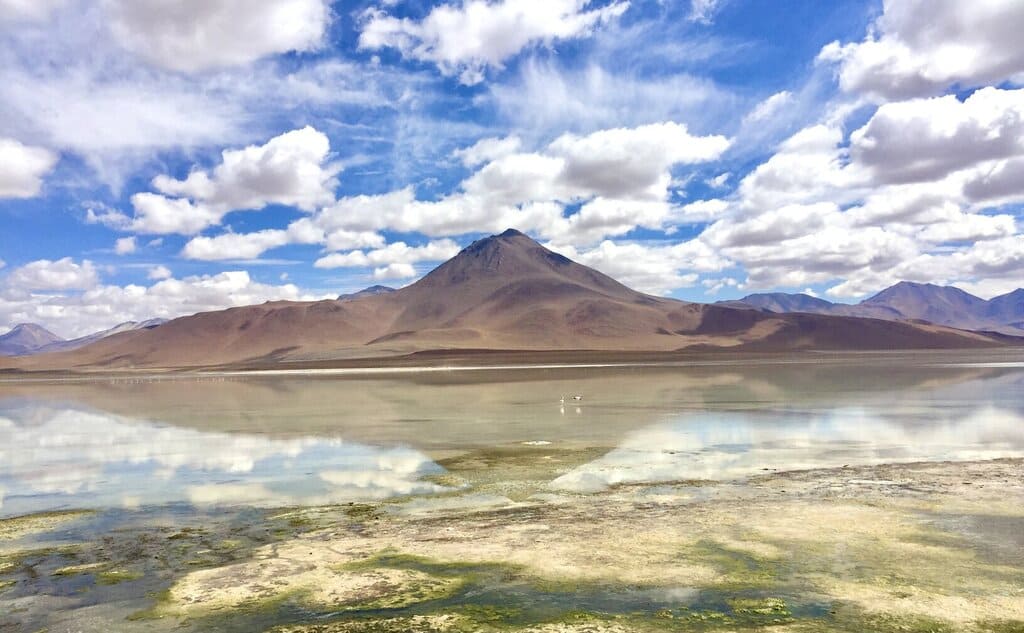
Key stops on day 1
Some of the key stops on the first day are:
- Laguna Verde (green lake)
- Laguna Blanca (white lake)
- Sol de Mañana (geothermal area with smoking ponds and geysers)
- Laguna Colorada (red lake known for its flamingos)
- Desierto Salvador Dalí (Salvador Dali desert, named after the painter due to its raw and rugged terrain)
- Termas de Polques (hot springs, just a tiny pool, I didn’t go in)

Driving around this park, you really feel like you’ve left earth and landed on Mars. The scenes of flamingos eating from pink and red lakes with snow-capped volcanoes in the background are simply stunning. You’ll have plenty of time to walk around all these uniquely colorful lakes and take photos.
Day 2
The second day is a long day in the Land Cruiser, the focus being on getting to Salar de Uyuni for the night. But you will pass quite a few more lakes and odd rock formations, such as Arbol de Piedra (Tree rock), a rock that resembles a tree. It’s the closest thing you’ll get to seeing an actual tree on this tour. The region between Eduardo Avaroa National Reserve and Salar de Uyuni is barren, with funky rock formations protruding from the desert sand everywhere you look.
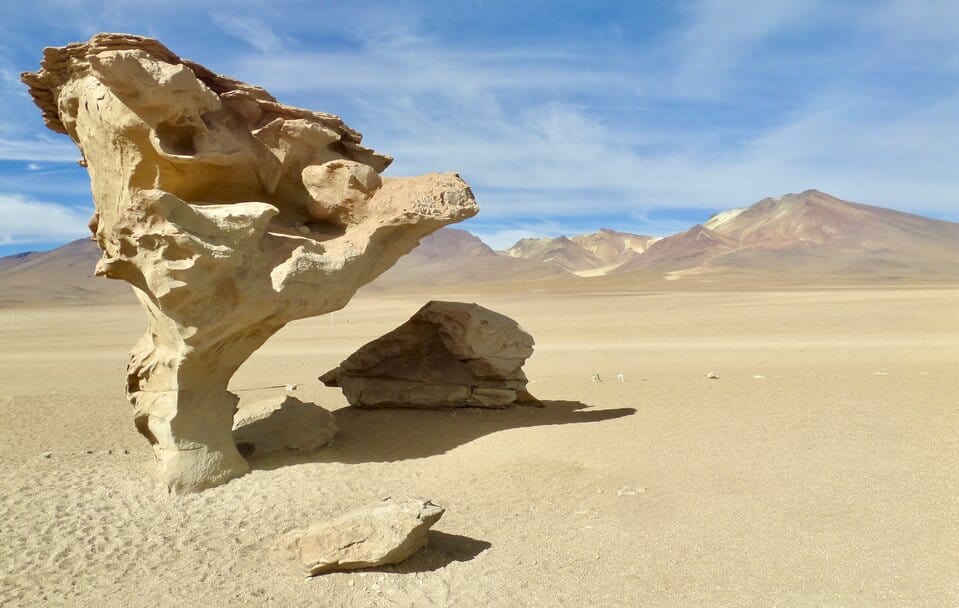
You might stop in the tiny town of Villa Martin to try some quinoa beer. Quinoa production is one of the main sources of income in this part of Bolivia. There are quinoa farms all over the place around here. The quinoa beer is expensive compared to everything else in Bolivia, but do the locals a favor and try it.
Here in town you’ll also see your first sightings of the Bolivian echinopsis atacamensis. This is a cactus species that looks strikingly similar to the American saguaro cactus found in Arizona. I love cacti so I was super excited to see these things growing in Bolivia.

You will spend the second night of the tour in a hostel literally made out of salt. We stayed at the Hostel de Sal, but if you don’t stay there it will be something similar. Instead of using stone or brick and mortar to build masonry structures, they use salt blocks in this part of the world. Even the tables, beds, and furniture were made of salt. Everything except the roof. I found this building made of salt absolutely fascinating.
Key stops on day 2
The second day on tour isn’t quite as other-worldly as the first day, but you’ll still see some cool things like:
- Tree Rock
- Villa Martin
- Hostel de Sal
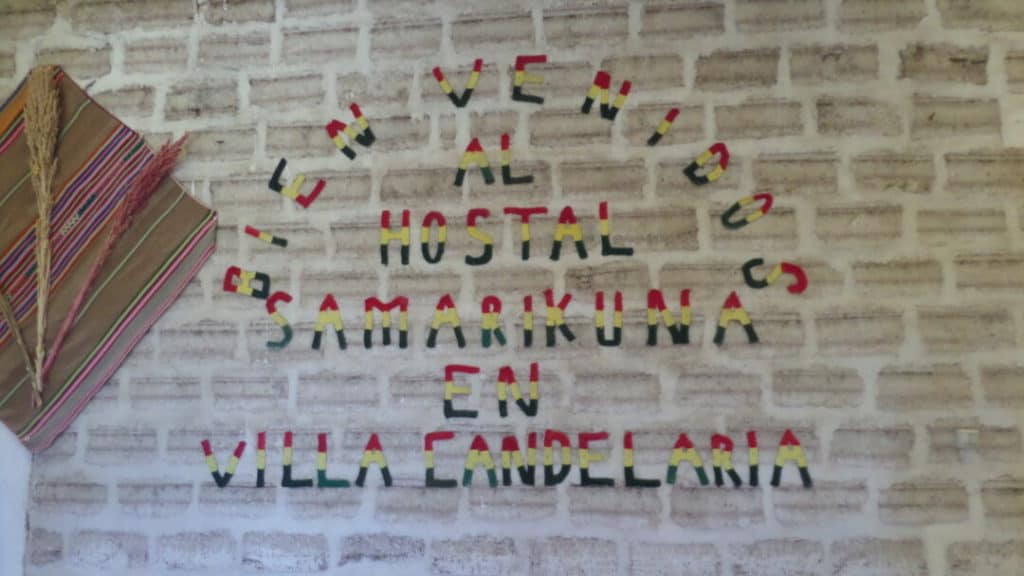
Day 3
You’ll wake early – like 4:30 AM early – to get an early start to the day. The sun rises early and you will watch it from an “island” in the salt flats. Salar de Uyuni – the Bolivian salt flats – is the highlight of the tour. It’s what you came all this way for.
An endless field of white salt with seams in a hexagonal format (hard to describe, refer to the photos), cactus-clad mountains in the background.
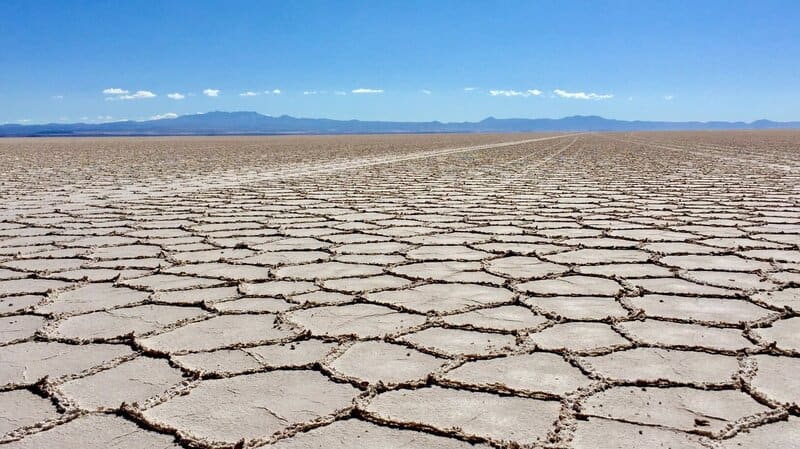
The “island” actually was an island once when the salt flat was at the bottom of the ocean, but today it’s more of just a little mountain in the middle of the flats. Climb up to the highest point on the island for a beautiful view of the sun rising over the white valley floor. You’ll have a little time to watch the sun illuminate the salt flats before breakfast, which you’ll enjoy at the base of the island.
If you like this cacti then you’ll love Saguaro National Park in Arizona!

The rest of the morning you will get time to find an isolated spot of the salt flats and experiment with some perspective pictures. See my examples below. The flats are huge so your driver will know of somewhere he can take you to get away from other people.
Not including sunrise on the island and breakfast, you’ll probably get about an hour on the flats for photos, which is enough time in my opinion. When you’re done at the world’s largest and highest salt flats you will head east towards the town of Uyuni.
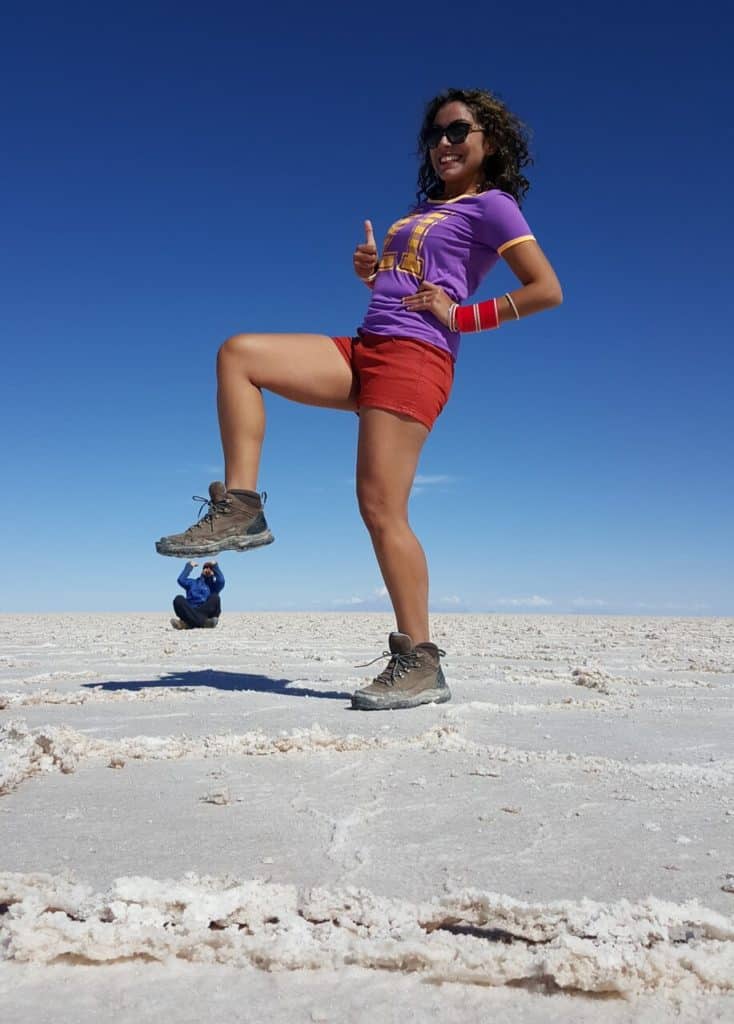
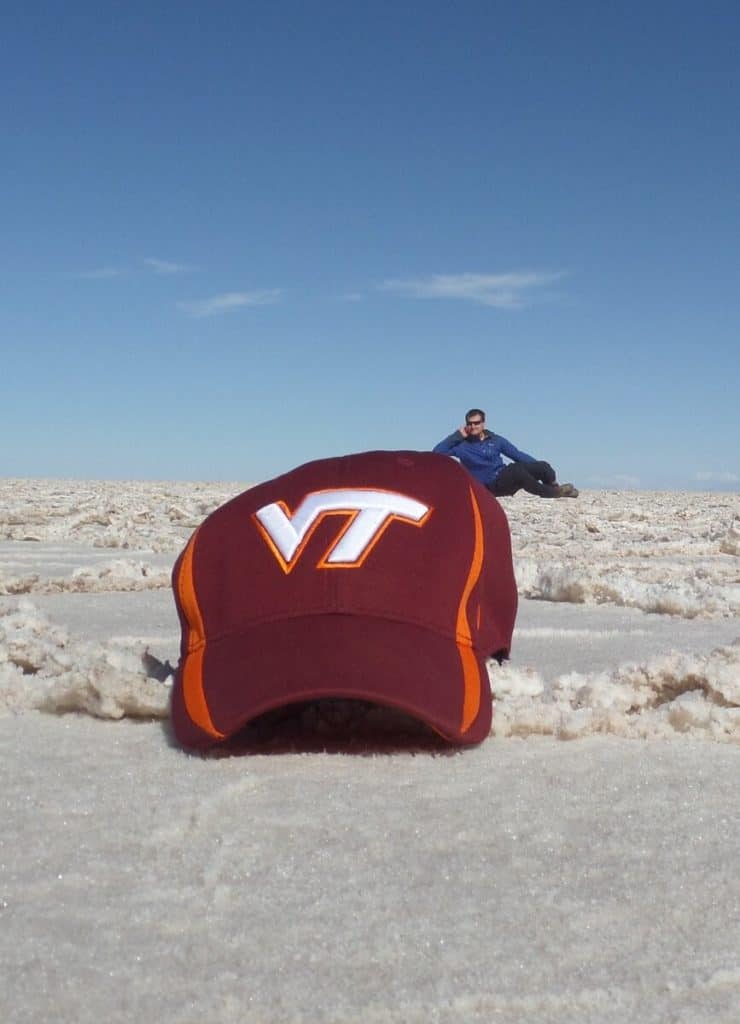
Uyuni town
There are a few more spots along the way where you’ll stop for lunch and shopping should you wish to buy something, then you’ll arrive in Uyuni and check out a place called the Train Cemetery just south of town. This place is full of rusted steel shells of old trains.
You’ll get about two hours of free time in Uyuni before it’s time to start on your way back to San Pedro. There is not much to see in Uyuni itself. We ended up just going to a café and sitting out in the sun with a beer.
Just note that if you purchase any fresh produce you cannot take it back to Chile, so you will have to finish it before the next morning. We did not know this at the time and ended up chowing down on four giant mangos for dessert that night.
Key stops on day 3
You will make better time on the way back to San Pedro as there will not be any stops. You even get to drive on some paved roads. We stayed in a small village called Villamar Mallcu on the way back. The highlights of your third day are:
- The salt flats at Salar de Uyuni
- Uyuni town
- Train Cemetery
Day 4
You will again wake up at the crack of dawn so the driver can take you back to the Chilean border by about 11 AM, where the bus will be waiting to take you back to San Pedro. What a journey it has been!
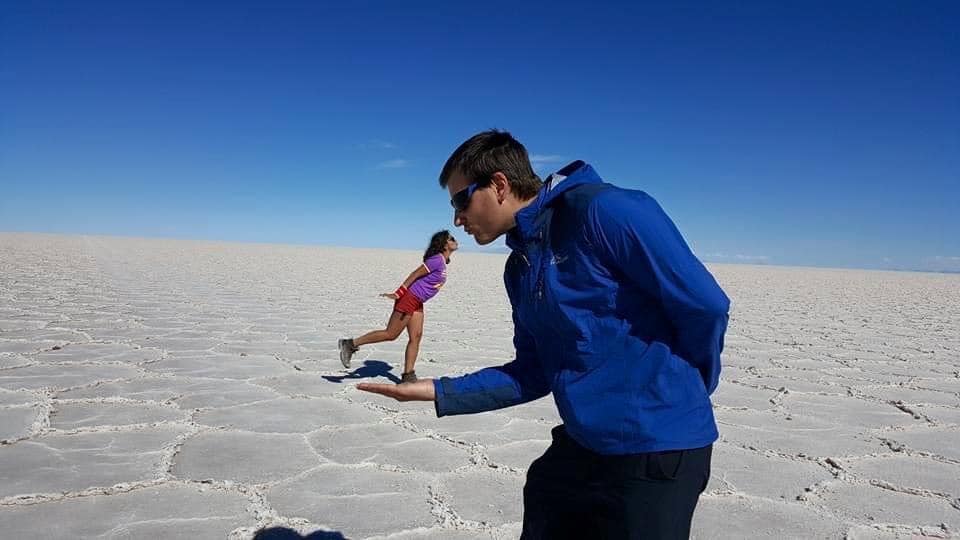
Final Word
The 4 day / 3 night tour from San Pedro de Atacama to Salar de Uyuni is a trip I recommend everyone to take at some point in their life. The entire journey is stunning and you’ll see some of the most spectacular volcanic landscapes the world has to offer.
Even when including the cost of the Bolivian visa for Americans, the trip is still worth it and very affordable for what you get. I hope you have a great time on your adventure through Bolivia!


10 comments
[…] comfort but also contribute positively to the places they visit. Look for those who have received positive traveler reviews for their commitment to […]
Thank you for the detailed summary of your trip. One question: how rough was the ride on the unpaved roads in the jeep? Were all extremities flying around or was it more of a constant shake? My gf has problems with her spine, so any upfront information would be really helpful to us. Thanks in advance!
Hi Mathias,
I don’t recall it being too bumpy, but it is all dirt roads or just open sand, and it’s pretty tighlty packed in the Jeeps. I don’t believe the roads were in poor condition and think they were quite smoothe. But don’t quote me on that! I don’t think it will be a problem for someone with back problems, but it might be good to inquire with one of the tour operators as they will have the best info on the latest road conditions.
Nice summary. I know it’s possible to do the same trip but with Uyuni as final destination. Do you know a good company for this trip? I plan to go there next July. Thanks!
Hi Thierry,
I recommend Lithium Adventura. There’s a link to their webiste in the post. They offer the one way version as well. So I’d check them out!
Thanks Chris!
Hi Chris,
Another question: do you know if it’s possible to do a 4 or 5 day-trip from San Pedro to Uyuni or Tupiza *including* the Sud Lipez?
Thierry, I had to look up Sud Lipez, but I believe you’re referring to the volanic high mountains of southern Bolivia where the pink lakes are and the flamingos and all that stuff, right? The route to Salar de Uyuni goes through that region of Bolivia and tha majority of the tour is actually in that area. Unless you’re referring to somewhere else? I believe 3 nights 4 days is the longest tour, at least that Lithium offers. You might be able to contact them to request a custom tour though!
Great information folks! Thank you.
Glad you found it useful!